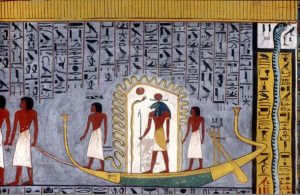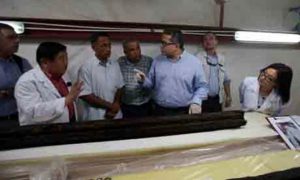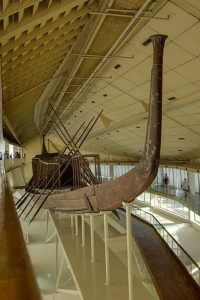
Egypt: Pharon Cheops' Solar Bar
 27. 03. 2017
27. 03. 2017

Egyptologists have made a surprising discovery of metal components on the Sun Barge of the Egyptian pharaoh Cheops. The metal eyes discovered during the excavations of Cheops' second Solar Ship near the Great Pyramid of Giza prove that the ancient Egyptians used far more advanced technologies in shipbuilding than we had previously thought.
A piece of wood uncovered during excavations near Cheops' Great Pyramid at Giza sheds new light on a hitherto known chapter on shipbuilding in ancient Egypt. The artifact contains the oldest examples of how people around the Nile used metal on their ships. Archaeologists reported that the metal parts - circular and U-shaped, came from one of the ships found in 1954 by Kamal el-Mallakh, along with the discovery of the famous Cheops solar ship.
Both ships have remained intact since they were buried in Giza. Both are so-called "sun barges", which were buried in a pit next to the royal tomb. We believe they were used for Pharaoh's funeral rites, probably as part of a procession. They may also have been related to the Egyptian belief in traveling to the afterlife.

The god Ra travels in his barge through the underworld, a copy from the Book of Gates in Ramses' tomb
The piece of wood is 8 m long, 40 cm wide and 4 cm thick. According to Mohamed Mostafy Abdel-Megeed, an official of the Ministry of Antiquities, this is the first sample of a piece of an ancient Egyptian ship that contains metal parts. Sakuji Yoshimura, an Egyptologist from Japan, says the eyes were used "to place the paddles to prevent the wood from rubbing against the wood."

Scientists of Khaled El-Enana, Sakuji Yoshimora, and Eissa Zidan are examining the plank in the laboratory
Cheops' solar ship is one of the oldest and largest ships of this ancient time. It is 43,6 m long and 5,9 m wide. It is a masterpiece of ancient art in shipbuilding.
Discoveries of entire ancient Egyptian ships are rare, but there are several very well-known specimens of these ritual ships. Their discovery will help researchers better understand the design of a ship that is similar to the design of ships used on the Nile. Some of them have recently been discovered. Alicia McDermott of Ancient Origins wrote on February 1, 2016:
"Czech archaeologists have uncovered an 18-meter-long ship near the tomb of an unknown member of the old royal elite class in Abu Sir, Egypt. /… / Archaeologists /… / said that the ship is unique and in good condition - a lot of planks and pins were found in their original positions. The Egyptian Ministry of Antiquities reported to the press that the remains of the nave were found on the stone surface and their orientation, length and pottery found in their interior led archaeologists to conclude that the nave dates from the end of the Third or Fourth Dynasty, about 2550 BC.April 2016 brought another discovery, a port site for a barge, built of stone blocks, from the time of Queen Hatshepsut, discovered on Elephant Island. Mark Miller wrote: "According to Dr. Felix Arnold, the field's field director, the building served as a resting place for the ceremonial barge of the god Chnum (God of creation and water). /… / The building was later dismantled and about 30 blocks were now found in the foundations of the temple of Chnum from the time of Pharaoh Nachthareheb (also known as Nektanebos II). Several blocks were discovered in previous excavation seasons by members of the Swiss Institute, but the significance of the blocks has only now been clarified. "





 1
1
